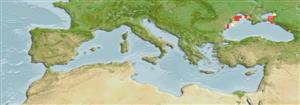分类 / Names
俗名 | 同种异名 | Catalog of Fishes(属, 种) | ITIS | CoL | WoRMS | Cloffa
Teleostei >
Clupeiformes (Herrings) >
Alosidae (Shads and Sardines)
Etymology: Alosa: Latin, alausa = a fish cited by Ausonius and Latin, halec = pickle, dealing with the Greek word hals = salt; it is also the old Saxon name for shad = "alli" ; 1591 (Ref. 45335).
Environment: milieu / climate zone / depth range / distribution range
生态学
海洋; 淡水; 半咸淡水; 溯河洄游 (Ref. 51243). 溫帶; 48°N - 37°N, 27°E - 54°E
Eurasia: Black Sea, Sea of Azov and Caspian Sea.
歐亞大陸: 黑海,亞速海與裡海。
大小 / 重量 / 年龄
Maturity: Lm ? range ? - ? cm
Max length : 32.0 cm TL 雄鱼/尚未辨别雌雄; (Ref. 593); common length : 20.0 cm SL 雄鱼/尚未辨别雌雄; (Ref. 188); 最大体重: 250.00 g (Ref. 593); 最大年龄: 7 年 (Ref. 10549)
背棘 (总数) : 0; 臀棘: 0. Body `shad-like', usually rather deep and compressed. Total gill rakers 50 to 180, long and thin, distinctly longer than filaments. Teeth poorly developed in jaws, sometimes barely detectable. A black spot posterior to gill opening and occasionally further black spots on flank in some cases.
身体像非鱼类一样的', 通常相当深而扁长形的。 总鳃耙 50 到 180, 长而细又明显长度超过丝状突起。 齿在颚中发展不良的, 有时几乎可发觉。 一个黑色的斑点在一些情况的侧面上在鳃裂与偶然进一步的黑色斑点后面。
Schooling and migratory (Ref. 188); at sea, pelagic in coastal waters with steady current and avoids areas with stable salinity; migrates from sea to mouth of large rives and spawns in fresh- or slightly brackish-water at shallow sites washed by flow of large rivers. Males migrate upriver at 2-3 years, females at 4-5; many individuals reproduce 2-4 seasons. Two migration peaks, one in late April (mostly males), one in early May (mostly females), entering rivers when temperature rises above 10°C. Spawns when temperature is at least 15°C, in May to June. Spawning usually occurs in the upper 3 m. Eggs semi-pelagic and demersal. Spent fish migrate back to the sea; juveniles migrate to sea during first summer, remaining there until they mature. Feeds mainly on zooplankton (copepods and mysids) when at sea (Ref. 59043). Depending on the subspecies (10 subspecies known), some are semi-anadromous and spawn in fresh or slightly saline waters, mainly in the lower reaches, whereas others are practically marine and spawn in brackish or even fully saline oceanic waters. One of the most warm-loving Alosa of the Caspian. Only A. a. caspia of the Caspian Sea is of commercial importance (Ref. 188).
群游性与回游的。 主要地在半淡咸水生存, 但是进入淡水到产卵。 依据亚种而定,一些是半-溯河洄游产卵而且产卵于淡水或微咸的水域中,主要在下面的范围, 人而其它实际海洋而且产卵于半咸淡或甚至完全盐的大洋性水域中。 里海者的最喜欢温暖 Alosa 之一。 吃浮游生物。 只有 A. 一。 里海的 caspia 是有商业重要性。 知道的 10个亚种。
Life cycle and mating behavior
成熟度 | 繁殖 | 产卵场 | 卵 | 孕卵数 | 仔鱼
Depending on the subspecies some are semi-anadromous and spawn in fresh or slightly saline waters, mainly in the lower reaches, whereas others are practically marine and spawn in brackish or even fully saline oceanic waters (Ref.188).There are two migration peaks, one in late April (mostly males) and one in early May (mostly females). Spent fish migrate back to sea. Juveniles migrate to sea during first summer, remaining at sea until they mature (Ref. 59043).歐亞大陸: 黑海,亞速海與裡海。
Whitehead, P.J.P., 1985. FAO Species Catalogue. Vol. 7. Clupeoid fishes of the world (suborder Clupeoidei). An annotated and illustrated catalogue of the herrings, sardines, pilchards, sprats, shads, anchovies and wolf-herrings. FAO Fish. Synop. 125(7/1):1-303. Rome: FAO. (Ref. 188)
世界自然保护联盟红皮书 (Ref. 130435: Version 2024-2)
人类利用
渔业: 高经济性
工具
特别资料
下载 XML
网络资源
Estimates based on models
Phylogenetic diversity index (Ref.
82804): PD
50 = 0.5000 [Uniqueness, from 0.5 = low to 2.0 = high].
Bayesian length-weight: a=0.00692 (0.00572 - 0.00837), b=3.09 (3.05 - 3.13), in cm total length, based on LWR estimates for this species (Ref.
93245).
营养阶层 (Ref.
69278): 3.5 ±0.46 se; based on food items.
Generation time: 3.7 ( na - na) years. Estimated as median ln(3)/K based on 1
growth studies.
回复力 (Ref.
120179): 中等的, 族群倍增时间最少 1.4 - 4.4年 (tmax=7).
Fishing Vulnerability (Ref.
59153): Low to moderate vulnerability (34 of 100).
Nutrients (Ref.
124155): Calcium = 16.7 [7.1, 87.1] mg/100g; Iron = 0.673 [0.290, 1.421] mg/100g; Protein = 19.1 [16.5, 21.8] %; Omega3 = 1.43 [0.76, 2.77] g/100g; Selenium = 10.4 [5.1, 20.6] μg/100g; VitaminA = 29.1 [7.3, 113.9] μg/100g; Zinc = 0.372 [0.231, 0.630] mg/100g (wet weight);
